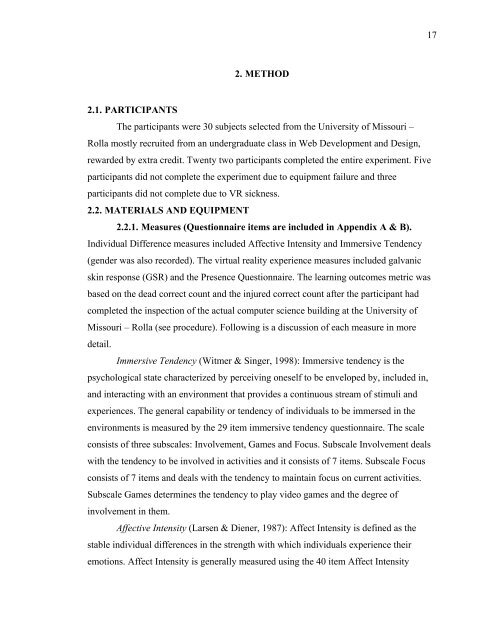Learning in Affectively Intense Virtual Environments - LITE
Learning in Affectively Intense Virtual Environments - LITE
Learning in Affectively Intense Virtual Environments - LITE
You also want an ePaper? Increase the reach of your titles
YUMPU automatically turns print PDFs into web optimized ePapers that Google loves.
17<br />
2. METHOD<br />
2.1. PARTICIPANTS<br />
The participants were 30 subjects selected from the University of Missouri –<br />
Rolla mostly recruited from an undergraduate class <strong>in</strong> Web Development and Design,<br />
rewarded by extra credit. Twenty two participants completed the entire experiment. Five<br />
participants did not complete the experiment due to equipment failure and three<br />
participants did not complete due to VR sickness.<br />
2.2. MATERIALS AND EQUIPMENT<br />
2.2.1. Measures (Questionnaire items are <strong>in</strong>cluded <strong>in</strong> Appendix A & B).<br />
Individual Difference measures <strong>in</strong>cluded Affective Intensity and Immersive Tendency<br />
(gender was also recorded). The virtual reality experience measures <strong>in</strong>cluded galvanic<br />
sk<strong>in</strong> response (GSR) and the Presence Questionnaire. The learn<strong>in</strong>g outcomes metric was<br />
based on the dead correct count and the <strong>in</strong>jured correct count after the participant had<br />
completed the <strong>in</strong>spection of the actual computer science build<strong>in</strong>g at the University of<br />
Missouri – Rolla (see procedure). Follow<strong>in</strong>g is a discussion of each measure <strong>in</strong> more<br />
detail.<br />
Immersive Tendency (Witmer & S<strong>in</strong>ger, 1998): Immersive tendency is the<br />
psychological state characterized by perceiv<strong>in</strong>g oneself to be enveloped by, <strong>in</strong>cluded <strong>in</strong>,<br />
and <strong>in</strong>teract<strong>in</strong>g with an environment that provides a cont<strong>in</strong>uous stream of stimuli and<br />
experiences. The general capability or tendency of <strong>in</strong>dividuals to be immersed <strong>in</strong> the<br />
environments is measured by the 29 item immersive tendency questionnaire. The scale<br />
consists of three subscales: Involvement, Games and Focus. Subscale Involvement deals<br />
with the tendency to be <strong>in</strong>volved <strong>in</strong> activities and it consists of 7 items. Subscale Focus<br />
consists of 7 items and deals with the tendency to ma<strong>in</strong>ta<strong>in</strong> focus on current activities.<br />
Subscale Games determ<strong>in</strong>es the tendency to play video games and the degree of<br />
<strong>in</strong>volvement <strong>in</strong> them.<br />
Affective Intensity (Larsen & Diener, 1987): Affect Intensity is def<strong>in</strong>ed as the<br />
stable <strong>in</strong>dividual differences <strong>in</strong> the strength with which <strong>in</strong>dividuals experience their<br />
emotions. Affect Intensity is generally measured us<strong>in</strong>g the 40 item Affect Intensity


